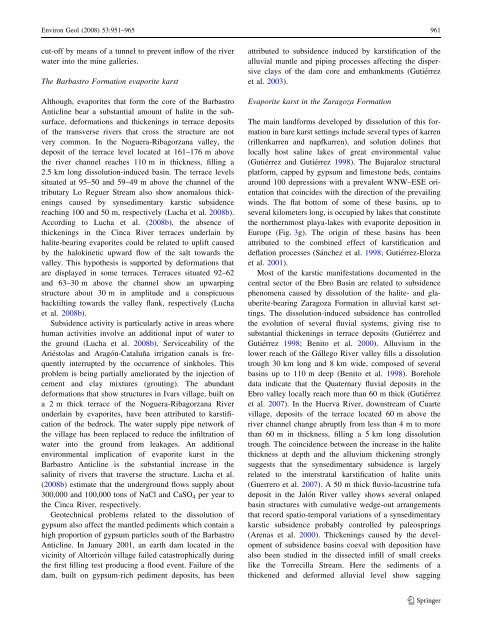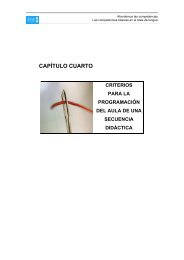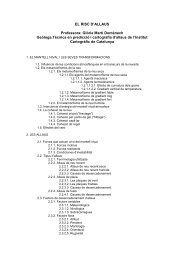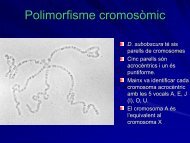Geological and environmental implications of the evaporite karst in Spain
Geological and environmental implications of the evaporite karst in Spain
Geological and environmental implications of the evaporite karst in Spain
Create successful ePaper yourself
Turn your PDF publications into a flip-book with our unique Google optimized e-Paper software.
Environ Geol (2008) 53:951–965 961<br />
cut-<strong>of</strong>f by means <strong>of</strong> a tunnel to prevent <strong>in</strong>flow <strong>of</strong> <strong>the</strong> river<br />
water <strong>in</strong>to <strong>the</strong> m<strong>in</strong>e galleries.<br />
The Barbastro Formation <strong>evaporite</strong> <strong>karst</strong><br />
Although, <strong>evaporite</strong>s that form <strong>the</strong> core <strong>of</strong> <strong>the</strong> Barbastro<br />
Anticl<strong>in</strong>e bear a substantial amount <strong>of</strong> halite <strong>in</strong> <strong>the</strong> subsurface,<br />
deformations <strong>and</strong> thicken<strong>in</strong>gs <strong>in</strong> terrace deposits<br />
<strong>of</strong> <strong>the</strong> transverse rivers that cross <strong>the</strong> structure are not<br />
very common. In <strong>the</strong> Noguera-Ribagorzana valley, <strong>the</strong><br />
deposit <strong>of</strong> <strong>the</strong> terrace level located at 161–176 m above<br />
<strong>the</strong> river channel reaches 110 m <strong>in</strong> thickness, fill<strong>in</strong>g a<br />
2.5 km long dissolution-<strong>in</strong>duced bas<strong>in</strong>. The terrace levels<br />
situated at 95–50 <strong>and</strong> 59–49 m above <strong>the</strong> channel <strong>of</strong> <strong>the</strong><br />
tributary Lo Reguer Stream also show anomalous thicken<strong>in</strong>gs<br />
caused by synsedimentary <strong>karst</strong>ic subsidence<br />
reach<strong>in</strong>g 100 <strong>and</strong> 50 m, respectively (Lucha et al. 2008b).<br />
Accord<strong>in</strong>g to Lucha et al. (2008b), <strong>the</strong> absence <strong>of</strong><br />
thicken<strong>in</strong>gs <strong>in</strong> <strong>the</strong> C<strong>in</strong>ca River terraces underla<strong>in</strong> by<br />
halite-bear<strong>in</strong>g <strong>evaporite</strong>s could be related to uplift caused<br />
by <strong>the</strong> halok<strong>in</strong>etic upward flow <strong>of</strong> <strong>the</strong> salt towards <strong>the</strong><br />
valley. This hypo<strong>the</strong>sis is supported by deformations that<br />
are displayed <strong>in</strong> some terraces. Terraces situated 92–62<br />
<strong>and</strong> 63–30 m above <strong>the</strong> channel show an upwarp<strong>in</strong>g<br />
structure about 30 m <strong>in</strong> amplitude <strong>and</strong> a conspicuous<br />
backtilt<strong>in</strong>g towards <strong>the</strong> valley flank, respectively (Lucha<br />
et al. 2008b).<br />
Subsidence activity is particularly active <strong>in</strong> areas where<br />
human activities <strong>in</strong>volve an additional <strong>in</strong>put <strong>of</strong> water to<br />
<strong>the</strong> ground (Lucha et al. 2008b). Serviceability <strong>of</strong> <strong>the</strong><br />
Ariéstolas <strong>and</strong> Aragón-Cataluña irrigation canals is frequently<br />
<strong>in</strong>terrupted by <strong>the</strong> occurrence <strong>of</strong> s<strong>in</strong>kholes. This<br />
problem is be<strong>in</strong>g partially ameliorated by <strong>the</strong> <strong>in</strong>jection <strong>of</strong><br />
cement <strong>and</strong> clay mixtures (grout<strong>in</strong>g). The abundant<br />
deformations that show structures <strong>in</strong> Ivars village, built on<br />
a 2 m thick terrace <strong>of</strong> <strong>the</strong> Noguera-Ribagorzana River<br />
underla<strong>in</strong> by <strong>evaporite</strong>s, have been attributed to <strong>karst</strong>ification<br />
<strong>of</strong> <strong>the</strong> bedrock. The water supply pipe network <strong>of</strong><br />
<strong>the</strong> village has been replaced to reduce <strong>the</strong> <strong>in</strong>filtration <strong>of</strong><br />
water <strong>in</strong>to <strong>the</strong> ground from leakages. An additional<br />
<strong>environmental</strong> implication <strong>of</strong> <strong>evaporite</strong> <strong>karst</strong> <strong>in</strong> <strong>the</strong><br />
Barbastro Anticl<strong>in</strong>e is <strong>the</strong> substantial <strong>in</strong>crease <strong>in</strong> <strong>the</strong><br />
sal<strong>in</strong>ity <strong>of</strong> rivers that traverse <strong>the</strong> structure. Lucha et al.<br />
(2008b) estimate that <strong>the</strong> underground flows supply about<br />
300,000 <strong>and</strong> 100,000 tons <strong>of</strong> NaCl <strong>and</strong> CaSO4 per year to<br />
<strong>the</strong> C<strong>in</strong>ca River, respectively.<br />
Geotechnical problems related to <strong>the</strong> dissolution <strong>of</strong><br />
gypsum also affect <strong>the</strong> mantled pediments which conta<strong>in</strong> a<br />
high proportion <strong>of</strong> gypsum particles south <strong>of</strong> <strong>the</strong> Barbastro<br />
Anticl<strong>in</strong>e. In January 2001, an earth dam located <strong>in</strong> <strong>the</strong><br />
vic<strong>in</strong>ity <strong>of</strong> Altorricón village failed catastrophically dur<strong>in</strong>g<br />
<strong>the</strong> first fill<strong>in</strong>g test produc<strong>in</strong>g a flood event. Failure <strong>of</strong> <strong>the</strong><br />
dam, built on gypsum-rich pediment deposits, has been<br />
attributed to subsidence <strong>in</strong>duced by <strong>karst</strong>ification <strong>of</strong> <strong>the</strong><br />
alluvial mantle <strong>and</strong> pip<strong>in</strong>g processes affect<strong>in</strong>g <strong>the</strong> dispersive<br />
clays <strong>of</strong> <strong>the</strong> dam core <strong>and</strong> embankments (Gutiérrez<br />
et al. 2003).<br />
Evaporite <strong>karst</strong> <strong>in</strong> <strong>the</strong> Zaragoza Formation<br />
The ma<strong>in</strong> l<strong>and</strong>forms developed by dissolution <strong>of</strong> this formation<br />
<strong>in</strong> bare <strong>karst</strong> sett<strong>in</strong>gs <strong>in</strong>clude several types <strong>of</strong> karren<br />
(rillenkarren <strong>and</strong> napfkarren), <strong>and</strong> solution dol<strong>in</strong>es that<br />
locally host sal<strong>in</strong>e lakes <strong>of</strong> great <strong>environmental</strong> value<br />
(Gutiérrez <strong>and</strong> Gutiérrez 1998). The Bujaraloz structural<br />
platform, capped by gypsum <strong>and</strong> limestone beds, conta<strong>in</strong>s<br />
around 100 depressions with a prevalent WNW–ESE orientation<br />
that co<strong>in</strong>cides with <strong>the</strong> direction <strong>of</strong> <strong>the</strong> prevail<strong>in</strong>g<br />
w<strong>in</strong>ds. The flat bottom <strong>of</strong> some <strong>of</strong> <strong>the</strong>se bas<strong>in</strong>s, up to<br />
several kilometers long, is occupied by lakes that constitute<br />
<strong>the</strong> nor<strong>the</strong>rnmost playa-lakes with <strong>evaporite</strong> deposition <strong>in</strong><br />
Europe (Fig. 3g). The orig<strong>in</strong> <strong>of</strong> <strong>the</strong>se bas<strong>in</strong>s has been<br />
attributed to <strong>the</strong> comb<strong>in</strong>ed effect <strong>of</strong> <strong>karst</strong>ification <strong>and</strong><br />
deflation processes (Sánchez et al. 1998; Gutiérrez-Elorza<br />
et al. 2001).<br />
Most <strong>of</strong> <strong>the</strong> <strong>karst</strong>ic manifestations documented <strong>in</strong> <strong>the</strong><br />
central sector <strong>of</strong> <strong>the</strong> Ebro Bas<strong>in</strong> are related to subsidence<br />
phenomena caused by dissolution <strong>of</strong> <strong>the</strong> halite- <strong>and</strong> glauberite-bear<strong>in</strong>g<br />
Zaragoza Formation <strong>in</strong> alluvial <strong>karst</strong> sett<strong>in</strong>gs.<br />
The dissolution-<strong>in</strong>duced subsidence has controlled<br />
<strong>the</strong> evolution <strong>of</strong> several fluvial systems, giv<strong>in</strong>g rise to<br />
substantial thicken<strong>in</strong>gs <strong>in</strong> terrace deposits (Gutiérrez <strong>and</strong><br />
Gutiérrez 1998; Benito et al. 2000). Alluvium <strong>in</strong> <strong>the</strong><br />
lower reach <strong>of</strong> <strong>the</strong> Gállego River valley fills a dissolution<br />
trough 30 km long <strong>and</strong> 8 km wide, composed <strong>of</strong> several<br />
bas<strong>in</strong>s up to 110 m deep (Benito et al. 1998). Borehole<br />
data <strong>in</strong>dicate that <strong>the</strong> Quaternary fluvial deposits <strong>in</strong> <strong>the</strong><br />
Ebro valley locally reach more than 60 m thick (Gutiérrez<br />
et al. 2007). In <strong>the</strong> Huerva River, downstream <strong>of</strong> Cuarte<br />
village, deposits <strong>of</strong> <strong>the</strong> terrace located 60 m above <strong>the</strong><br />
river channel change abruptly from less than 4 m to more<br />
than 60 m <strong>in</strong> thickness, fill<strong>in</strong>g a 5 km long dissolution<br />
trough. The co<strong>in</strong>cidence between <strong>the</strong> <strong>in</strong>crease <strong>in</strong> <strong>the</strong> halite<br />
thickness at depth <strong>and</strong> <strong>the</strong> alluvium thicken<strong>in</strong>g strongly<br />
suggests that <strong>the</strong> synsedimentary subsidence is largely<br />
related to <strong>the</strong> <strong>in</strong>terstratal <strong>karst</strong>ification <strong>of</strong> halite units<br />
(Guerrero et al. 2007). A 50 m thick fluvio-lacustr<strong>in</strong>e tufa<br />
deposit <strong>in</strong> <strong>the</strong> Jalón River valley shows several onlaped<br />
bas<strong>in</strong> structures with cumulative wedge-out arrangements<br />
that record spatio-temporal variations <strong>of</strong> a synsedimentary<br />
<strong>karst</strong>ic subsidence probably controlled by paleospr<strong>in</strong>gs<br />
(Arenas et al. 2000). Thicken<strong>in</strong>gs caused by <strong>the</strong> development<br />
<strong>of</strong> subsidence bas<strong>in</strong>s coeval with deposition have<br />
also been studied <strong>in</strong> <strong>the</strong> dissected <strong>in</strong>fill <strong>of</strong> small creeks<br />
like <strong>the</strong> Torrecilla Stream. Here <strong>the</strong> sediments <strong>of</strong> a<br />
thickened <strong>and</strong> deformed alluvial level show sagg<strong>in</strong>g<br />
123





